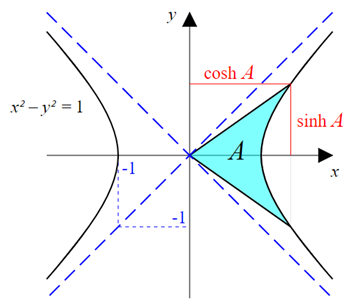Excel math hyperbolic functions: sinh, cosh, tanh, csch, sech, coth
Excel Function HYPERBOLIC FUNCTIONS
A hyperbolic function is a one which specifies the relationship between two distances; one from origin to a
point on the hyperbola and other from coordinate axes to the same point on the hyperbola.
The main difference between normal trigonometric functions and hyperbolic functions is that, the hyperbolic functions
form half a circle instead of full circle.

Excel Function SINH
The SINH() function is used to determine the hyperbolic sine value of the number specified.
This function takes single argument which is the angle expressed as number.
The angle is always in radian
If you want to use degree transform the angle before with =RADIANS(angle in degree)
| Angle(deg) | Angle (Rad) | Formula | SINH() |
| 0 | 0 | =SINH(M10) | 0 |
| 30 | 0.523598775598299 | =SINH(M11) | 0.54785347388804 |
| 90 | 1.5707963267949 | =SINH(M12) | 2.30129890230729 |
| 180 | 3.14159265358979 | =SINH(M13) | 11.5487393572577 |
| 360 | 6.28318530717959 | =SINH(M14) | 267.744894041016 |
Excel Function COSH
The COSH() function is used to determine the hyperbolic cosine value of the number specified.
This function takes single argument which is the angle expressed as number.
The angle is always in radian
If you want to use degree transform the angle before with =RADIANS(angle in degree)
| Angle(deg) | Angle (Rad) | Formula | COSH() |
| 0 | 0 | =COSH(M23) | 1 |
| 30 | 0.523598775598299 | =COSH(M24) | 1.14023832107643 |
| 90 | 1.5707963267949 | =COSH(M25) | 2.50917847865806 |
| 180 | 3.14159265358979 | =COSH(M26) | 11.5919532755215 |
| 360 | 6.28318530717959 | =COSH(M27) | 267.746761483748 |
Excel Function TANH()
The TANH() function is used to determine the hyperbolic tangent value of the number specified.
This function takes single argument which is the angle expressed as number.
The angle is always in radian
If you want to use degree transform the angle before with =RADIANS(angle in degree)
| Angle(deg) | Angle (Rad) | Formula | TANH() |
| 0 | 0 | =TANH(M36) | 0 |
| 30 | 0.523598775598299 | =TANH(M37) | 0.480472778156452 |
| 90 | 1.5707963267949 | =TANH(M38) | 0.917152335667274 |
| 180 | 3.14159265358979 | =TANH(M39) | 0.99627207622075 |
| 360 | 6.28318530717959 | =TANH(M40) | 0.999993025339611 |
Excel Function CSCH()
The CSCH() function is used to determine the hyperbolic cosine of the number specified.
This function takes single argument which is the angle expressed as number.
The angle is always in radian
If you want to use degree transform the angle before with =RADIANS(angle in degree)
| Angle(deg) | Angle (Rad) | Formula | CSCH() |
| 10 | 0.174532925199433 | =CSCH(M49) | 5.70059217731439 |
| 30 | 0.523598775598299 | =CSCH(M50) | 1.82530557468795 |
| 90 | 1.5707963267949 | =CSCH(M51) | 0.434537208094696 |
| 180 | 3.14159265358979 | =CSCH(M52) | 8.65895375300469E-02 |
| 360 | 6.28318530717959 | =CSCH(M53) | 3.73489848828567E-03 |
Excel Function SECH
The SECH() function is used to determine the hyperbolic secant of the number specified.
This function takes single argument which is the angle expressed as number.
The angle is always in radian
If you want to use degree transform the angle before with =RADIANS(angle in degree)
| Angle(deg) | Angle (Rad) | Formula | SECH() |
| 10 | 0.174532925199433 | =SECH(M62) | 0.984960079661621 |
| 30 | 0.523598775598299 | =SECH(M63) | 0.877009640454779 |
| 90 | 1.5707963267949 | =SECH(M64) | 0.398536815338387 |
| 180 | 3.14159265358979 | =SECH(M65) | 8.62667383340544E-02 |
| 360 | 6.28318530717959 | =SECH(M66) | 3.73487243863713E-03 |
Excel Function COTH
The COTH() function is used to determine the hyperbolic cotangent of the number specified.
This function takes single argument which is the angle expressed as number.
The angle is always in radian
If you want to use degree transform the angle before with =RADIANS(angle in degree)
| Angle(deg) | Angle (Rad) | Formula | COTH() |
| 10 | 0.174532925199433 | =COTH(M75) | 5.78763778860236 |
| 30 | 0.523598775598299 | =COTH(M76) | 2.08128336393364 |
| 90 | 1.5707963267949 | =COTH(M77) | 1.09033141072737 |
| 180 | 3.14159265358979 | =COTH(M78) | 1.00374187319732 |
| 360 | 6.28318530717959 | =COTH(M79) | 1.00000697470904 |